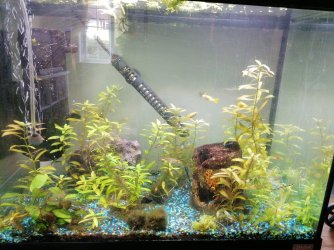Divinityinlove
Fish Crazy
So I finally found a plant which thrived in my tank (or atleast survived, all other decomposed), and this plant spread itself all over. I even pulled some out from the middle today because it was a jungle!
I've seen a lot of heavily planted and beautiful tanks on YouTube and I wanted plants! But nobody ever mentioned these... Maybe they had bigger fish... But ...
My query is concerning two things, 1) since there's no way of vacuuming gravel now without uprooting and replanting all plants which I'm guessing people with heavily planted tanks don't do as it wouldn't be good for the plants?? Do you just rely on plants to convert all the crap to their food and that's it? I don't want to damage plant by deep cleaning.
2) Sorry if this question sounds cold hearted but sometimes it happens... when you cannot see if a fish has dropped dead, as they sometimes inexplicably do...How do you ensure your tank isn't being contaminated with decomposing fish? I was concerned about this hence removing some plants down the middle to create more space, this gives them less hiding places though... But me more visibility if a fish has dropped. Whilst cleaning today, I did find a female betta decomposing. I'm also sure I'm missing 2 male guppies but cannot see them anywhere.
(Just a side note, since I have enquired about one male guppies tail, I did some research and was also told by the fish exprrt that female bettas would be fine in a large group of make guppies. More than males for sure) I am hoping guppies and betta females haven't been hurting each other because I NEVER see them fighting during the day... Some of you said the tail was betta damage but I NEVER see nipping and I watch them a lot, especially during feeding.)
I've seen a lot of heavily planted and beautiful tanks on YouTube and I wanted plants! But nobody ever mentioned these... Maybe they had bigger fish... But ...
My query is concerning two things, 1) since there's no way of vacuuming gravel now without uprooting and replanting all plants which I'm guessing people with heavily planted tanks don't do as it wouldn't be good for the plants?? Do you just rely on plants to convert all the crap to their food and that's it? I don't want to damage plant by deep cleaning.
2) Sorry if this question sounds cold hearted but sometimes it happens... when you cannot see if a fish has dropped dead, as they sometimes inexplicably do...How do you ensure your tank isn't being contaminated with decomposing fish? I was concerned about this hence removing some plants down the middle to create more space, this gives them less hiding places though... But me more visibility if a fish has dropped. Whilst cleaning today, I did find a female betta decomposing. I'm also sure I'm missing 2 male guppies but cannot see them anywhere.
(Just a side note, since I have enquired about one male guppies tail, I did some research and was also told by the fish exprrt that female bettas would be fine in a large group of make guppies. More than males for sure) I am hoping guppies and betta females haven't been hurting each other because I NEVER see them fighting during the day... Some of you said the tail was betta damage but I NEVER see nipping and I watch them a lot, especially during feeding.)



 /) Since they got fungus (and white spot actually) I decided to remove the carbon in order to medicate them as per instructions. When reading about why I have to remove carbon, I read that carbon also removes fertilizer! So, I've decided to keep it out for a period of time and see if it makes a difference to the plants. HOWEVER...
/) Since they got fungus (and white spot actually) I decided to remove the carbon in order to medicate them as per instructions. When reading about why I have to remove carbon, I read that carbon also removes fertilizer! So, I've decided to keep it out for a period of time and see if it makes a difference to the plants. HOWEVER...